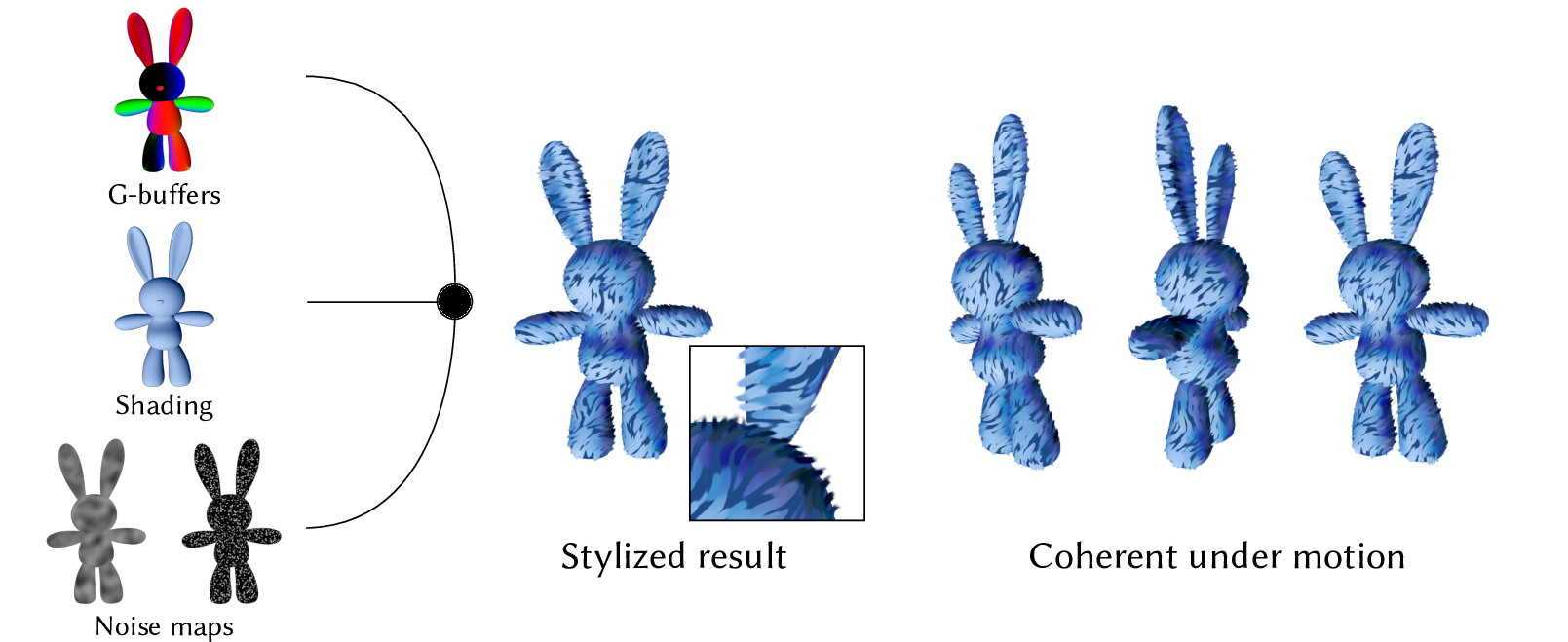Section: New Results
Expressive Rendering
A workflow for designing stylized shading effects
Participants : Alexandre Bléron, Romain Vergne, Thomas Hurtut, Joëlle Thollot.
In this report [18], we describe a workflow for designing stylized shading effects on a 3D object, targeted at technical artists. Shading design, the process of making the illumination of an object in a 3D scene match an artist vision, is usually a time-consuming task because of the complex interactions between materials, geometry, and lighting environment. Physically based methods tend to provide an intuitive and coherent workflow for artists, but they are of limited use in the context of non-photorealistic shading styles. On the other hand, existing stylized shading techniques are either too specialized or require considerable hand-tuning of unintuitive parameters to give a satisfactory result. Our contribution is to separate the design process of individual shading effects in three independent stages: control of its global behavior on the object, addition of procedural details, and colorization. Inspired by the formulation of existing shading models, we expose different shading behaviors to the artist through parametrizations, which have a meaningful visual interpretation. Multiple shading effects can then be composited to obtain complex dynamic appearances. The proposed workflow is fully interactive, with real-time feedback, and allows the intuitive exploration of stylized shading effects, while keeping coherence under varying viewpoints and light configurations (see Fig. 2). Furthermore, our method makes use of the deferred shading technique, making it easily integrable in existing rendering pipelines.
|
MNPR: A framework for real-time expressive non-photorealistic rendering of 3D computer graphics
Participants : Santiago Montesdeoca, Hock Soon Seah, Amir Semmo, Pierre Bénard, Romain Vergne, Joëlle Thollot, Davide Benvenuti.
We propose a framework for expressive non-photorealistic rendering of 3D computer graphics: MNPR. Our work focuses on enabling stylization pipelines with a wide range of control, thereby covering the interaction spectrum with real-time feedback. In addition, we introduce control semantics that allow cross-stylistic art-direction, which is demonstrated through our implemented watercolor, oil and charcoal stylizations (see Fig. 3). Our generalized control semantics and their style-specific mappings are designed to be extrapolated to other styles, by adhering to the same control scheme. We then share our implementation details by breaking down our framework and elaborating on its inner workings. Finally, we evaluate the usefulness of each level of control through a user study involving 20 experienced artists and engineers in the industry, who have collectively spent over 245 hours using our system. MNPR is implemented in Autodesk Maya and open-sourced through this publication, to facilitate adoption by artists and further development by the expressive research and development community. This paper was presented at Expressive [13] and received the best paper award.
Motion-coherent stylization with screen-space image filters
Participants : Alexandre Bléron, Romain Vergne, Thomas Hurtut, Joëlle Thollot.
One of the qualities sought in expressive rendering is the 2D impression of the resulting style, called flatness. In the context of 3D scenes, screen-space stylization techniques are good candidates for flatness as they operate in the 2D image plane, after the scene has been rendered into G-buffers. Various stylization filters can be applied in screen-space while making use of the geometrical information contained in G-buffers to ensure motion coherence. However, this means that filtering can only be done inside the rasterized surface of the object. This can be detrimental to some styles that require irregular silhouettes to be convincing. In this paper, we describe a post-processing pipeline that allows stylization filters to extend outside the rasterized footprint of the object by locally inflating the data contained in G-buffers (see Fig. 4). This pipeline is fully implemented on the GPU and can be evaluated at interactive rates. We show how common image filtering techniques, when integrated in our pipeline and in combination with G-buffer data, can be used to reproduce a wide range of digitally-painted appearances, such as directed brush strokes with irregular silhouettes, while keeping enough motion coherence. This paper was presented at Expressive [11].





